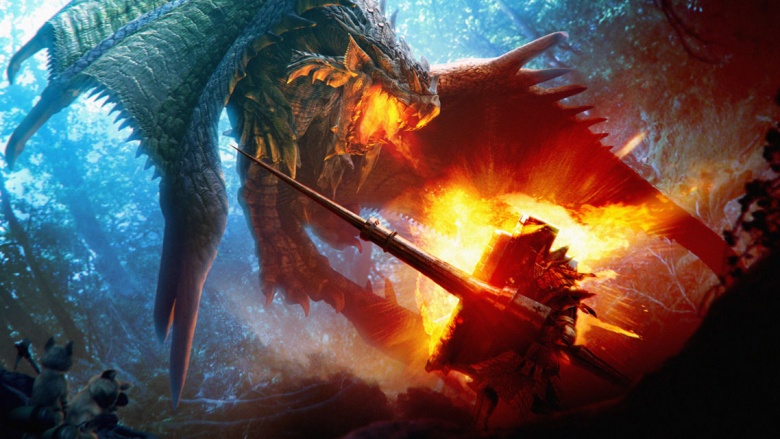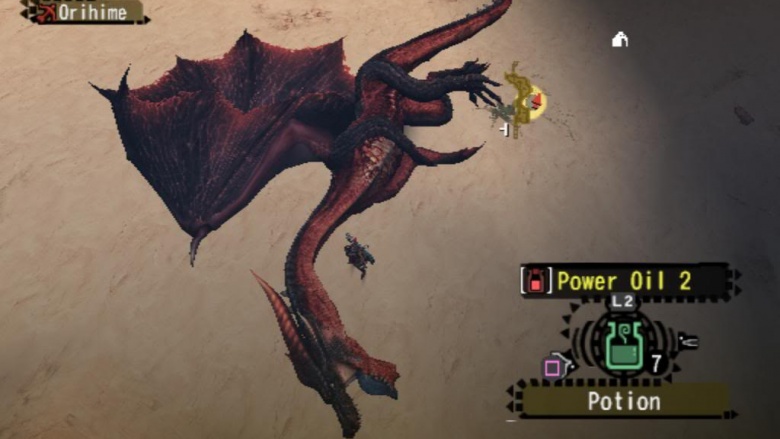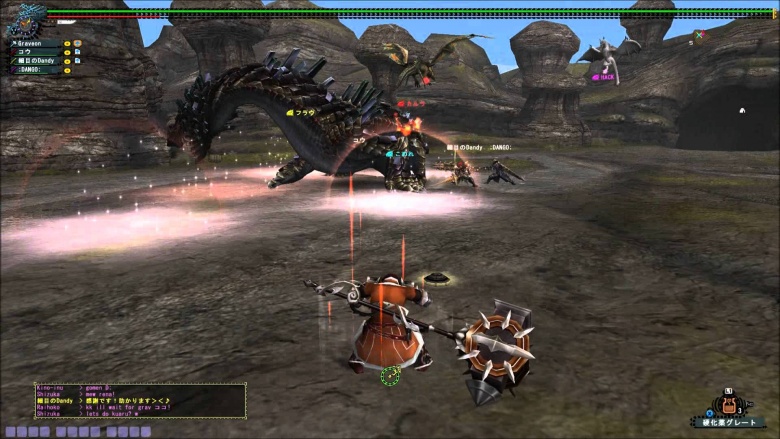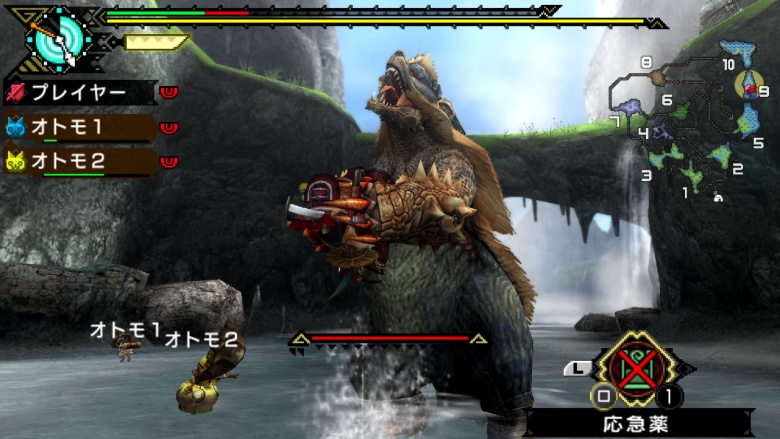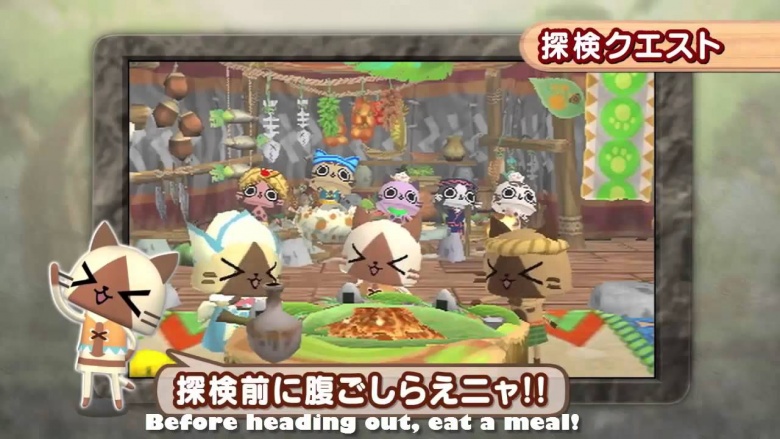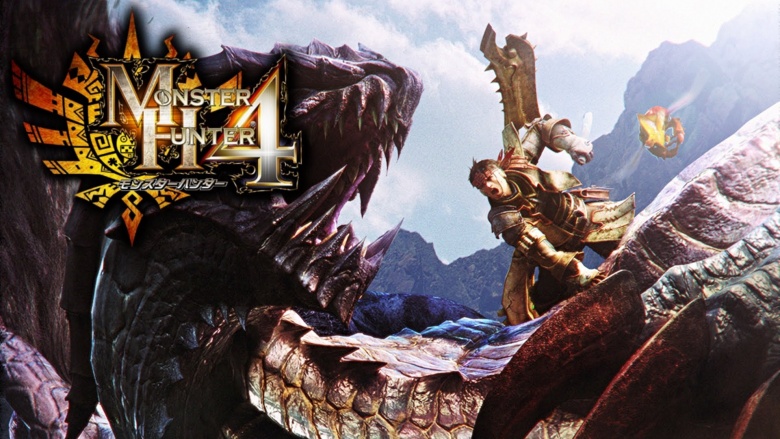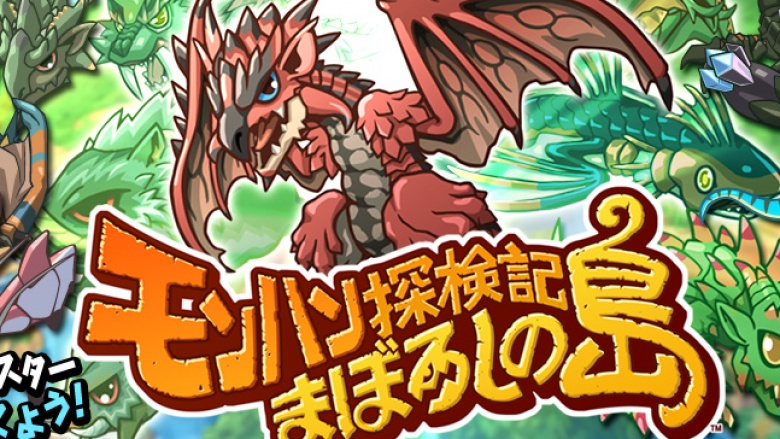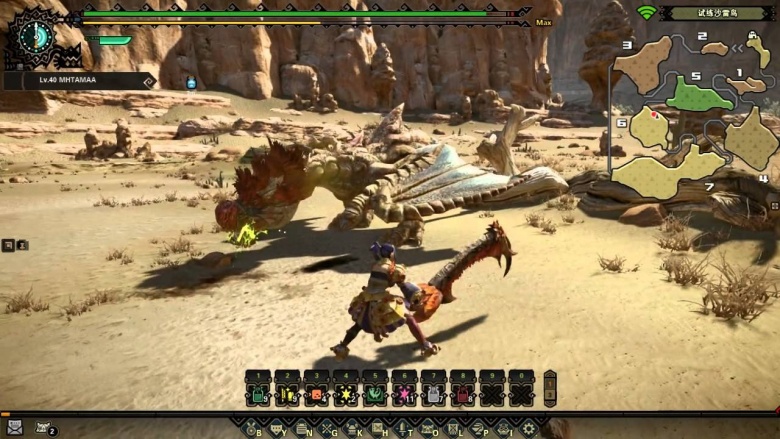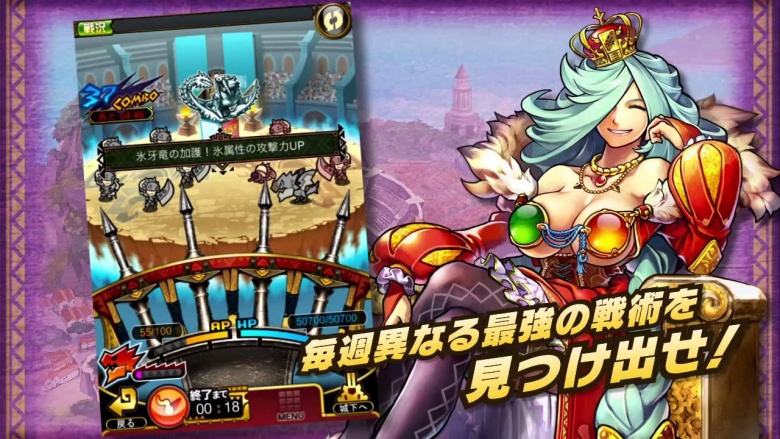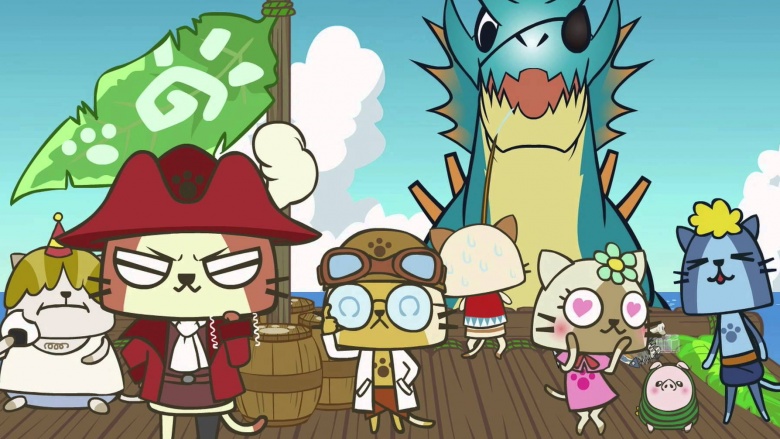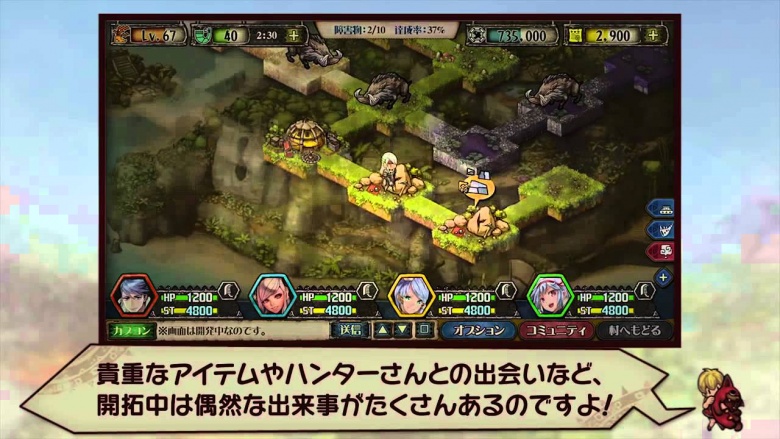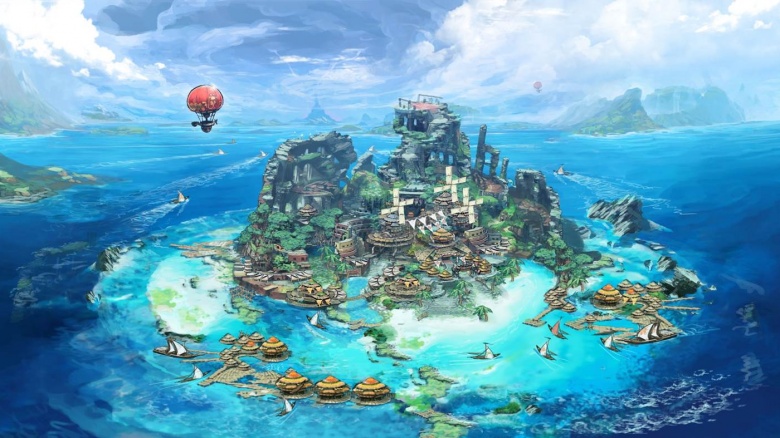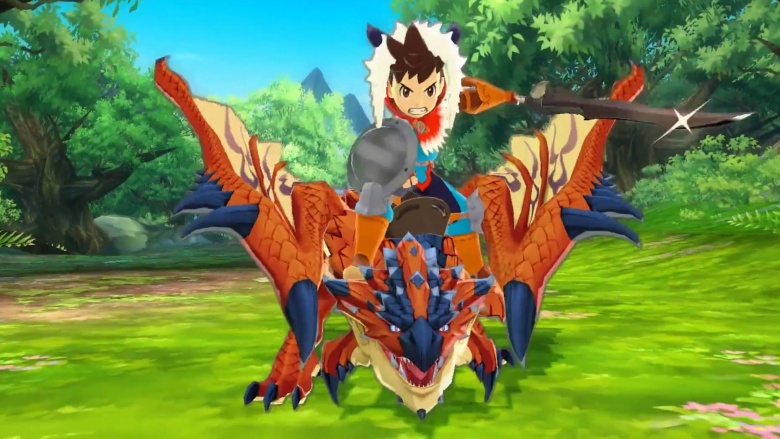The Monster Hunter Games You Can't Get In America
Monster Hunter, Capcom's series of action role-playing games, is notoriously hostile to newcomers, but that hasn't stopped it from becoming a major sensation—especially in its home country. Last year, Monster Hunter X sold more than 3.2 million Japanese copies during its first month in stores. It's not just a game franchise, either: in Japan, Monster Hunter has spawned a popular anime, a manga series, and a collectible trading card game.
In America, critics like Monster Hunter, and sales are on the rise—the latest entry to arrive in the west, Monster Hunter 4 Ultimate, moved over a million copies. However, in the USA, Monster Hunter is still a considered cult curiosity; for some reason, it hasn't caught on in America like it has overseas, and given how much time, effort, and money goes into translating and marketing, many Monster Hunter games will never see the light of day on western shores.
Monster Hunter G (2005)
The original Monster Hunter hit the American PlayStation 2 in November, 2004, roughly six months after its Japanese release. It wasn't a hit. The game received mediocre reviews, and its multiplayer servers didn't survive past 2007, negating one of its main selling points (in Japan, Monster Hunter's popularity kept the servers' lights on until 2011).
That's probably why we never got Monster Hunter G, an expanded version of the original game, which came to the PlayStation 2 in 2005 and the Nintendo Wii in 2009. Mechanically, Monster Hunter G is virtually identical to its predecessor. It's the extra content that makes G special: new quests and new monsters (many of which are resized and/or recolored versions of the original game's quarry), an updated skill system, and Felyne chefs—basically, anthropomorphic cats who cook meals that provide players with stat bonuses. The game later moved to smartphones as Monster Hunter i, a stripped-down port that removed multiplayer and added a monthly subscription fee. Most of Monster Hunter G's innovations found their way west in the PlayStation Portable's Monster Hunter Freedom, which brought Monster Hunter G onto a portable system, but American fans who want to play this pseudo-expansion on the big screen are still, sadly, out of luck.
Monster Hunter 2 (2006)
Common wisdom holds that Monster Hunter didn't really take off until it hit portable systems, which are much more popular in Japan than in the United States and Europe, but Capcom decided to stick with the PlayStation 2 for Monster Hunter's first direct sequel. Monster Hunter 2 builds on the original's foundation by adding new monsters and weapon upgrades as well as the gem system, which allows players to strengthen their weapons by attaching objects forged from metal ore and collected monster parts.
Given the west's lackluster response to the first Monster Hunter game, it's no surprise that the sequel didn't make it to the US—at least, not right away. While the PlayStation 2 edition of Monster Hunter 2 was a Japanese-only release, North America received both Monster Hunter Freedom 2 and its expansion, Monster Hunter Freedom Unite. Not only did these re-releases, which appeared on both the PlayStation Portable and Apple mobile devices, make Monster Hunter 2 portable, but both of those games improved on their predecessor by adding more quests, new weapons, and a better inventory on top of all of the original's monster hunting-goodness. Americans may not have played Monster Hunter 2 in its original form, but thanks to Freedom 2 and Freedom Unite's extra features, it's safe to say that they didn't miss much.
Monster Hunter: Frontier Online (2007)
Multiplayer, whether through the internet or via ad-hoc local connection, has always been a key part of the Monster Hunter franchise, but few Monster Hunter games are fully-fledged massively multiplayer online role-playing games (think World of Warcraft). Monster Hunter: Frontier Online brings Monster Hunter's core gameplay into a living, ongoing virtual world that players can access through their PCs or Xbox 360s. Remarkably, while many MMORPGs have crumbled and disappeared over the past decade, after ten years Monster Hunter: Frontier Online is still going strong.
In fact, it's so successful that it has not one but two sequels. Monster Hunter: Frontier G started as an expansion pack for Frontier Online before it turned into a stand-alone title. Monster Hunter: Frontier Z, the game's latest iteration, moved the franchise onto next-generation consoles with a PlayStation 4 edition.
Sadly, Monster Hunter: Frontier Online is only officially available in Japan, Taiwan, and Korea (although some tech-savvy players have found their way around the game's regional restrictions). Connecting is only half the challenge, of course. To play on Japanese servers, you'll need to put up with a $14-per-month subscription fee. The Korean version of the game is free, but unless you have a Korean social security number, you're out of luck. In 2013, Capcom hinted at a Monster Hunter: Frontier G release in western regions, but so far, nothing has come of it.
Monster Hunter Portable Third (2010)
Despite the name, Monster Hunter Portable Third isn't actually the third entry in the Monster Hunter series—that would be Monster Hunter Tri, a Wii game that came out in 2009. Instead, Monster Hunter Portable Third is a brand-new game that also happens to be the third Monster Hunter title released for the PlayStation Portable. The game also received a high-definition remake called Monster Hunter Portable Third HD ver., which came out on the PlayStation 3 and isn't actually portable at all.
Confused yet? Don't worry. At its core, Monster Hunter Portable Third is just like the other Monster Hunter games: players go on quests, kill some beasts, upgrade their gear, and repeat. While Monster Hunter Portable Third removes some of the series' more advanced features—no underwater exploration, for example—it also improves on others by restoring some previously abandoned weapon types and giving the franchise a complete graphical overhaul.
Monster Hunter Diary: Poka Poka Felyne Village (2010)
"Cute" isn't a word that's usually associated with Monster Hunter, and yet, Monster Hunter Diary Poka Poka Felyne Village is downright adorable. Starring the Felyne, Monster Hunter's helpful anthropomorphic kitties, Monster Hunter Diary Poka Poka Felyne Village forgoes the series' lush and detailed graphics for a friendly and cartoony graphics that resemble Nintendo's Miis, with hints of Animal Crossing in both the art design and gameplay.
In Monster Hunter Diary, players manage a village full of Felyne who can be sent on quests or partake in mini-games like fishing, mining, and a fairly robust pig racing simulation. While questing, players won't control their party directly. Instead, they issue instructions to the Felyne using the PlayStation Portable's controller buttons, which tell the kitties to move forward, burrow underground, or perform context-dependent actions like attacking or playing the flute. The player's main Felyne and various parts of the village (including the Felyne's house) can be customized with cute furniture and decorations. Monster Hunter fans can even sync Monster Hunter Diary with their Monster Hunter Portable Second G save files to unlock special items.
Monster Hunter Diary Poka Poka Felyne Village is a big departure from Monster Hunter's rigorous track-n'-slash gameplay, but it proved popular enough to spawn both an expansion pack (2011's Monster Hunter Diary Poka Poka Felyne Village G) and a Nintendo 3DS remake, which came out in 2015 as Monster Hunter Diary Poka Poka Felyne Village DX.
Monster Hunter 4 (2011)
Stop us if you've heard this one before: a Monster Hunter game is developed for Japan, becomes a hit, and gets an international re-release about a year later. Yes, once again, the Nintendo 3DS' Monster Hunter 4 was originally a Japanese exclusive—and, once again, western fans got an expanded and improved version when the expanded version (in this case, Monster Hunter 4 Ultimate) debuted in 2012.
It's a good thing, too, because Monster Hunter 4 is the first portable Monster Hunter game to include fully-featured online gameplay, something that had been a staple on console versions since the first Monster Hunter arrived on the PlayStation 2 in 2004. Combat also received an overhaul, with more focus on fighting in a fully 3D space, and Capcom's developers softened the series' notoriously steep learning curve to make it more palatable for western gamers. American gamers might've had to wait a little bit longer, but it was worth it—Capcom: Monster Hunter 4 Ultimate was the first entry in the series to move over 1 million copies in western markets.
Monster Hunter: Phantom Island Voyage (2011)
Monster Hunter is huge. Pokémon is, too. Adding the two together would create the biggest, most popular game of all time, right? That's just simple math.
In Monster Hunter: Phantom Island Voyage, players didn't really hunt monsters. Instead, they hatched and raised them, trained them, and then pitted them against one another in battle. Players could compete head-to-head, or could team up to take on gigantic boss monsters. Basically, Monster Hunter: Phantom Island Voyage sounds like the Monster Hunter and Pokémon mash-up of fans' dreams, but things didn't quite work out. Not only was the game a Japanese exclusive confined to mobile phones but, judging by a rough translation on the game's official site, the entire service was shut down in 2014. Bummer.
Monster Hunter Online (2013)
Like Monster Hunter: Frontier Online, Monster Hunter Online is a massively multiplayer online role-playing game (MMORPG) set in the Monster Hunter universe. Players arm themselves with weapons of their choice, then venture into the wilderness by themselves or with other players to hunt down a wide variety of creatures.
But Monster Hunter Online isn't the same as Monster Hunter: Frontier Online. For one, it's only available on PC. Secondly, it's developed by Tencent, the Chinese gaming company that owns Supercell (the company behind Clash of Clans) and Riot Games (home of League of Legends), and not Capcom, Monster Hunter's creator and the developer of almost every other Monster Hunter game. Monster Hunter Online is also free-to-play, and while it's officially a Chinese-only release, Tencent has given its blessing to a fan-made English translation, meaning that you too can partake in Tencent's sprawling Monster Hunter adventure—as long as you're willing to get your hands a little dirty.
Monster Hunter Big Game Hunting Quest (2013)
Japanese role-playing games and collectible card games go hand-in-hand. Final Fantasy VIII introduced players to Triple Triad, a card-battling mini-game that proved so popular that it's been featured in both Final Fantasy XIV and a standalone mobile app. The second Kingdom Hearts game, Kingdom Hearts: Chain of Memories, replaces Kingdom Hearts' action-heavy combat with a card-based battling system that remains controversial among fans. The World Ends With You uses cards to drive combat (at least on one of the two Nintendo DS' screens), as does the cult-classic Baten Kaitos.
Monster Hunter is no exception. In the mobile-only game Monster Hunter Big Game Hunting Quest, players hunt down monsters using a deck of cards, which grows more powerful as the game progresses. Monster Hunter Big Game Hunting Quest features a competitive multiplayer challenges, collaborative fights involving up to 50 players, special timed events, retro-style graphics that evoke classic Super Nintendo JRPGs like Final Fantasy and Chrono Trigger, and, in a franchise-first, an all-female cast.
MonHun always Felyne Life (2013), Monster Hunter Felyne Bazaar (2013), and Felyne Puzzle (2012)
Can't get enough of Monster Hunter's cat-like mascots, the Felyne? If you live in Japan, Capcom has you covered with not one but three spin-off titles starring the cuddly little creatures. Felyne Puzzle is a Monster Hunter-themed version of Capcom's popular falling-tile game Puzzle Fighter, and should appeal to fans of games like Tetris, Bejeweled, and Candy Crush. In Monster Hunter Felyne Bazaar, players build the ultimate Felyne shopping center by employing different Felyne as shopkeepers, sending other Felyne out to collect supplies and craft inventory, and then sitting back and watching the money roll in. In MonHun always Felyne Life, players try to become the king of the cats by managing over 300 types of Felyne as they quest for weapons, armor, and rare items.
Monster Hunter Mezeporta Reclamation (2014)
The Monster Hunter series has spawned multiple titles on consoles, handhelds, desktop computers, and mobile devices, but there's only one official Monster Hunter game that's playable directly in your web browser. That's Monster Hunter Mezeporta Reclamation, a strategy game co-developed by Tencent and Capcom. In Mezeporta Reclamation, players must save Mezeporta (the main town in Monster Hunter G) by recruiting hunters—all of whom happen to be cute anime girls—and strategically deploying them against some of the series' signature beasts. As the village grows stronger, players do too, and correctly managing both the hunters and the city's resources is crucial if you want to restore Mezeporta's lost glory.
Monster Hunter Explore (2015)
While Monster Hunter Explore technically had an English port, it was never actually available in the United States—the game was released in Canada for three months in 2016, but didn't make it across the border before the online servers were shut down. That's too bad. While iOS and Android devices have plenty of Monster Hunter spin-offs, Monster Hunter Explore (also known as Monster Hunter Smart) was billed as "the first true Monster Hunter game for mobile" and featured traditional Monster Hunter gameplay, robust multiplayer features, and an enticing free-to-play revenue model. Unfortunately, the game experienced problems on devices that upgraded to iOS 9.3, and instead of fixing the title, Capcom pulled the plug on the international version entirely.
Monster Hunter Stories (2016)
Monster Hunter Stories is a Monster Hunter game without all of that pesky monster hunting. According to Monster Hunter producer Ryozo Tsujimoto, many fans are as interested in the Monster Hunter's fictional setting as they are in tracking and killing beasts. For them, Capcom made Monster Hunter Stories, which takes the focus away from the hunters and puts it on the monsters themselves.
In Monster Hunter Stories, players control a monster rider who steals monster eggs, raises the hatchlings, and then uses the creatures for both travelling and combat. Instead of the action-heavy combat of past Monster Hunter games, Monster Hunter Stories uses a turn-based battle system sort of like Pokémon's, complete with a rock-paper-scissors-like system of strengths and weaknesses. Naturally, there's a big focus on Monster Hunter lore in the game: according to Tsujimoto, the story is "enjoyable [to] a broad range of generations," and anything that the game doesn't cover is handled in the Monster Hunter Stories anime, which debuted on October 2, 2016—less than a week before the game.


